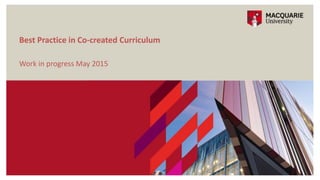
Co creation presentation may 2015 (1) (1)
- 1. Work in progress May 2015 Best Practice in Co-created Curriculum
- 2. Co-created curriculum 2PACE Two broad bodies of knowledge: 1. Co-creation of curriculum in the partner context (literature by indigenous NGOs and academics) 2. Co-creation of curriculum in the university context (literature by NGOs and academics engaging with partners in-country – fields of CBSL / ISL) While we are primarily concerned with (2.) our work needs to intersect with and contribute to (1.) Approach
- 3. Co-created curriculum 3PACE Broadly speaking, three stages can be identified: 1. Identify related problems and opportunities in the community i.e. read one’s social reality. 2. Determine the HR capabilities required to address these problems. NB scientific and technological knowledge requirements 3. Design curriculum (various constituencies – local population, government, NGOs and universities) (Arbab, Correa and da Valcarel, 1988; FUNDAEC, (nd); Leach and Little, 1999; Helu-Thaman, 2014; Nabobo-Baba, 2012) Co-creation in the partner context
- 4. Co-created curriculum 4PACE Stage (3.) – Curriculum design As stage 3 is dependent on (1.) and (2.) i.e. we need to know: - the scope and nature of the problems in our partner communities; - the opportunities that present; - the HR capabilities required to address the problems. (Crabtree, 2013; Hatcher and Bringle, 2010; Kahn, 2011) → This information will determine the foci of our workshop. (Visits to partners will be key here.) NB The involvement of Unit Convenors to provide expertise (in areas outside those of the research team) will be important. Co-creation in the university context
- 5. Co-created curriculum 5PACE Drawing on information from stages 1. and 2. the following questions arise: 1. What are our students’ resources and how can they be developed in line with partner needs (and MQ grad caps)? In collaboration with partners: 2. What are the corresponding concepts? 3. What content should be covered and what should students research prior to visit? 4. What activities can be developed through which students can acquire and develop their capabilities? 5. What structured reflective components can be developed? (Bringle and Hatcher, 2011; Crabtree, 2008; Smith-Paríolá and Gòkè-Paríolá, 2006) Curriculum design
- 6. Co-created curriculum 6PACE Cyclical approach: The above questions should follow a sequence of research, action and learning through a series of consecutive approximations. (Arbab and Correa, 1998; Wadsworth, 2010) Workshop with partners: 1. Define – framing presentation to more clearly define the workshop objectives 2. Explore – open space sessions, nuts and bolts, success factors 3. Design – develop blueprints, share commitments , synthesise commonalities in models , seek feedback from participants (USAID, SIDA, Reboot & Civicus, 2014) Principles in practice
- 7. Co-created curriculum 7PACE Reflection - Where possible reflect with host communities - Structure to enable a new interpretation of events and deeper understanding of host communities Reflexivity -engage in introspection to offset biases Student attitudes to be developed - open mindedness, willingness to learn from host community; concept of self as active agent of own learning, etc. (Chambers, 2013; Eyler, & Giles, 1999; Hammersley, 2014) Considerations
- 8. Co-created curriculum 8PACE Reciprocity – the organising principle Challenges: - Different objectives: student learning / community goals - Power differential - Partner staff may not accurately represent interest of their community (Crabtree, 2008; Grusky 2000). Next steps… Further considerations
- 9. Co-created Curriculum 9PACE Arbab, F., Correa, G. and da Valcarel, F. (1988). FUNDAEC: its principles and its activities. Cali, Colombia, Celater. Retrieved May 20, 2015 from http://www.fundaec.org/en/institution/celater_doc.htm Bringle, R., Hatcher, J. and Jones S. (Eds.) (2011). International Service Learning: Conceptual Frameworks and Research. Sterling, Stylus. Chambers, R. (2013). ‘Participation for development: A good time to be alive’ Development Bulletin. 75, April, 2-3. Crabtree, R. (2008). ‘Theoretical Foundations for International Service Learning’ Michigan Journal of Community Service Learning, Fall, 18-36. Crabtree, R. (2013). ‘The intended and unintended consequences of international service-learning’ in The Journal of Higher Education, Outreach and Engagement, 17:2, 43-66. Eyler, J. and Giles, D. (1999). Where is the learning in service learning? San Francisco, Jossey Bass. FUNDAEC, (nd). Retrieved May 17, 2015 from http://www.fundaec.org/en/ Grusky, S. (2000). ‘International Service learning’ American Behavioural Scientist.43, 858-867. Hammersley, L. (2013). ‘Volunteer Tourism: Building effective relationships of understanding’. Journal of Sustainable Tourism, 22: 6, 855-873. Hatcher, J. and Bringle, R. (2010). ‘Reflection: Bridging the gap between service and learning.’ Retrieved May 20, 2015 from http://www.tandfonline.com/doi/abs/10.1080/87567559709596221 References
- 10. Co-created Curriculum 10PACE Helu-Thaman, K. (2014). ‘Towards cultural democracy in university teaching and research with special reference to the Pacific Island region’ in C. Mason and F. Rawlings-Sanaei, (Eds.) Academic Migration, Discipline Knowledge and Pedagogical Practice: Voices from the Asia-Pacific. Singapore, Springer. Kahn, H. (2011). Overcoming the Challenges of International Service learning’ in R. Bringle, J. Hatcher and S. Jones (Eds.) International Service Learning: Conceptual Frameworks and Research. Sterling, Stylus. 113-124. Leach, F. and Little, A. (1999). Education, Cultures, and Economic: Dilemmas for Development. New York, Falmer. Nabobo-Baba, U. (2012). ‘Transformations from within: Rethinking Pacific Education Initiative. The development of a movement for social justice and equity’, The International Education Journal: of Comparative Perspectives, 2012, 11(2), 82–97. Smith-Paríolá, J. and Gòkè-Paríolá, A. (2006). ‘Expanding the parameters of service-learning: a case study’, Journal of Studies in International Education. 10:1 71-86. USAID, SIDA, Reboot and CIVICUS. 2014. ‘Co-creating the Civil Society Innovation Initiative’. Retrieved May 20, 2015 from http://reboot.org/wordpress/wp-content/uploads/2015/02/USAID_CivSocInno_ProcessNote_%C6%92_web.pdf Wadsworth, Y. (2010). Building in Research and Evaluation. Crows Nest, Allen & Unwin. References
- 11. Thank you END